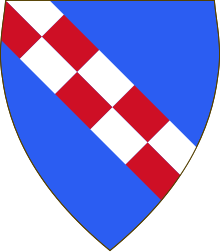| Coat of arms of the Hauteville family | |
|---|---|
 Dextera Domini fecit virtutem, Dextera Domini exaltavit me. The coat of arms is traced back to Roger II, who is said to have adopted it at his coronation as King of Sicily.[1] The Norman "bore as his insignia a duplicate bend, divided into five parts, that is, five red, and five silver, which descends from the right side to the left side crosswise, set in an azure field [...]: which according to the terms of the Blazon of arms [. ...], as composed of two principal colors, and of silver metal, signify nothing else, than an invincible spirit in acquiring supremacy; those insignia carved in stone were seen the years before in Naples above the third door of the Castel dell'Ovo [...]"[2]. | |
| Shield | Azure, a bend chequy of Gules and Argent.[3] |
The Hauteville coat of arms is the coat of arms by which the Siculo-Norman dynasty of Hauteville, founder of the Kingdom of Sicily and protagonist of the historical events of southern Italy during the 11th and 12th centuries, is represented. The actual use of a coat of arms by the lineage that had Tancred as its progenitor, however, is not an assumption that is undoubtedly proven or universally agreed upon. There are various reconstructions of the coat of arms, which the various authors have associated with the Hauteville family; the azure insignia with a bend chequy in argent and gules of two rows of tiles has been attested as the most widespread and most accepted representation.
- ^ Agostino Inveges, p. 14).
- ^ Giovanni Antonio Summonte, p. 33).
- ^ Angelo Scordo, 2012, p. 66).
